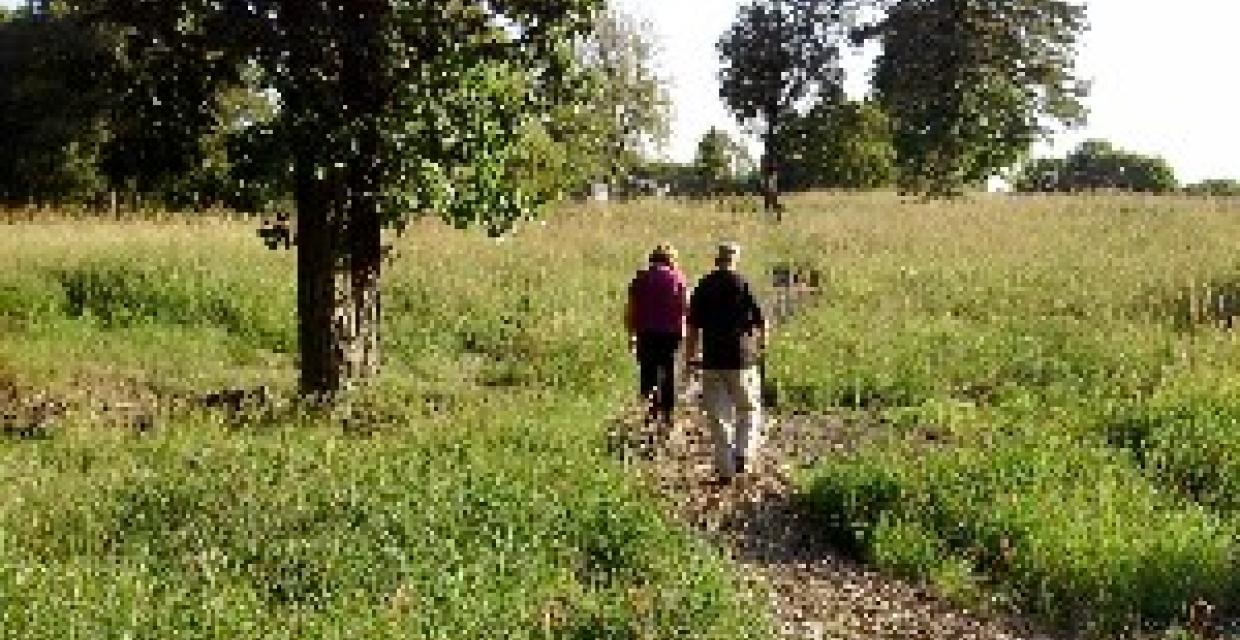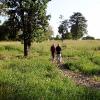Hilltop Reservation


Park Overview:
This is a site in transition from the grounds of long-abandoned Essex Mountain Sanatorium into a new, spacious suburban park on Second Watchung Mountain. Accessible from the Lenape Trail as a side trip
Park Description:
Hilltop Reservation is a relatively new nature preserve in one of the most densely populated counties in the United States. It is located on a site that formerly included the grounds of the Essex Mountain Sanatorium, and before that other public service institutions dating back to the mid-1870s. The Sanatorium was established in 1907 to treat tuberculosis patients; the effort was ultimately abandoned in 1977. The current and early 20th century names are revealing, because they draw attention to the fact the Reservation is elevated - namely a site on the Second Watchung Mountain [sometimes mistakenly called "Orange Mountain"]. The Watchung Mountains are a group of three long low ridges of volcanic origin, around 400 to 500 feet high, lying parallel to each other. For additional information, see the Trail Conference's Watchung Region.
The site is in transition since the NJ Department of Environmental Protection dedicated the land for conservation and recreational purposes in 2001. The Hilltop Conservancy, a private not-for-profit organization, has assumed a leading role to revive the site. The Reservation is part of the Essex County Park System.
Physically, Hilltop Reservation has the general shape of an irregular, long rectangle extending northeast from Verona - which is situated in a valley between the First and Second Watchungs -- to Cedar Grove. It parallels Fairview Avenue for much of the way, with smaller sections spreading out into Caldwell and North Caldwell. The Reservation's highest point is 670 feet.
Trails Overview:
The Reservation has eleven relatively short blazed trails ranging from 0.3 mile to 1.8 miles. Perhaps a reflection of its past as a sanatorium, one trail is named "Peace," another "More Peace.' The network of interlacing trails adds up to just short of nine miles, and provides several opportunities to plan loop hikes.
Use the Web Map link on this site to view a trail map. The map shows blazed trails with colors and symbols. On the ground only symbols mark the trails.
- An easy trail begins at the western entrance in North Caldwell [Mountain Avenue and Courter Lane], near a large sports field. It has an ample parking lot with a formal kiosk displaying a large-scale trail map. Near Courter Lane follow the Arrowhead-blazed trail, its pathway is paved initially and then becomes a woodchip/gravel roadway, finally reverting to pavement at its crest. It provides access to several other trails.
- A more challenging trail starts at the Verona Community Center parking area, at the southwestern end of the park in Verona, near the intersection of Bloomfield Avenue and Linn Drive [again look for ball fields]. The Old Hilltop Trail [diamond blaze] trailhead begins by the left field line of a baseball diamond and climbs up hill following the general northeast trajectory of the park. Several other trails in the park are intersected; the first is to the left where White Rock Trail [whose blaze resembles a pyramid with its peak lopped off] passes by the intriguingly named "Prisoners Pond," ultimately to rejoin the Old Hilltop Trail further along.
- Two additional parking areas and trailheads are located along Fairview Avenue on the park's eastern side. The 34-mile Lenape Trail, also visible on the trail map, passes by Hilltop Reservation near Verona High School. Plans are someday to reroute this trail through the park.
Click to view a photo album taken during a January hike in the park.
Note: biking is restricted to paved roads within the park.
Park Acreage:
284.16 acresMunicipality:
Verona, Cedar Grove, Caldwell, North CaldwellThis is a site in transition from the grounds of long-abandoned Essex Mountain Sanatorium into a new, spacious suburban park on Second Watchung Mountain. Accessible from the Lenape Trail as a side trip
Hilltop Reservation is a relatively new nature preserve in one of the most densely populated counties in the United States. It is located on a site that formerly included the grounds of the Essex Mountain Sanatorium, and before that other public service institutions dating back to the mid-1870s. The Sanatorium was established in 1907 to treat tuberculosis patients; the effort was ultimately...
Park Acreage:
284.16 acresMunicipality:
Verona, Cedar Grove, Caldwell, North CaldwellContact Information
Web Link:
The Hilltop ConservancyPhone:
Not availableFees:
NoneDogs in park:
Dogs on leashHike Checklist:
Whether you are going for a day hike or backpacking overnight, it is good practice to carry what we call The Hiking Essentials. These essentials will help you enjoy your outing more and will provide basic safety gear if needed. There may also be more essentials, depending on the season and your needs.
The Essentials
Hiking Shoes or Boots
Water - Two quarts per person is recommended in every season. Keep in mind that fluid loss is heightened in winter as well as summer. Don't put yourself in the position of having to end your hike early because you have run out of water.
Map - Know where you are and where you are going. Many of our hiking areas feature interconnecting network of trails. Use a waterproof/tear-resistant Tyvek Trail Conference map if available or enclose your map in a Ziplock plastic bag. If you have a mobile device, download Avenza’s free PDF Maps app and grab some GPS-enhanced Trail Conference maps (a backup Tyvek or paper version of the map is good to have just in case your batteries die or you don't have service). Check out some map-reading basics here.
Food - Snacks/lunch will keep you going as you burn energy walking or climbing. Nuts, seeds, and chocolate are favorites on the trail.
Sunscreen and insect repellent
Rain Gear and Extra Clothing - Rain happens. So does cold. Be prepared for changing weather. Avoid cotton--it traps water against your skin and is slow to dry. If you are wearing wet cotton and must return to your starting point, you risk getting chills that may lead to a dangerous hypothermia. Choose synthetic shirts, sweaters and/or vests and dress in layers for easy on and off.
Compass - A simple compass is all you need to orient you and your map to magnetic north.
Light - A flashlight or small, lightweight headlamp will be welcome gear if you find yourself still on the trail when darkness falls. Check the batteries before you start out and have extras in your pack.
First Aid Kit - Keep it simple, compact, and weatherproof. Know how to use the basic components.
Firestarter and Matches - In an emergency, you may need to keep yourself or someone else warm until help arrives. A firestarter (this could be as simple as leftover birthday candles that are kept inside a waterproof container) and matches (again, make sure to keep them in a waterproof container) could save a life.
Knife or Multi-tool - You may need to cut a piece of moleskin to put over a blister, repair a piece of broken equipment, or solve some other unexpected problem.
Emergency Numbers - Know the emergency numbers for the area you're going to and realize that in many locations--especially mountainous ones, your phone will not get reception.
Common Sense - Pay attention to your environment, your energy, and the condition of your companions. Has the weather turned rainy? Is daylight fading? Did you drink all your water? Did your companion fail to bring rain gear? Are you getting tired? Keep in mind that until you turn around you are (typically) only half-way to completing your hike--you must still get back to where you started from! (Exceptions are loop hikes.)
Check the weather forecast before you head out. Know the rules and regulations of the area.
The Leave No Trace Seven Principles
Plan Ahead and Prepare
- Know the regulations and special concerns for the area you'll visit.
- Prepare for extreme weather, hazards, and emergencies.
- Schedule your trip to avoid times of high use.
- Visit in small groups when possible. Consider splitting larger groups into smaller groups.
- Repackage food to minimize waste.
- Use a map and compass to eliminate the use of marking paint, rock cairns or flagging.
Travel and Camp on Durable Surfaces
- Durable surfaces include established trails and campsites, rock, gravel, dry grasses or snow.
- Protect riparian areas by camping at least 200 feet from lakes and streams.
- Good campsites are found, not made. Altering a site is not necessary.
- In popular areas:
- Concentrate use on existing trails and campsites.
- Walk single file in the middle of the trail, even when wet or muddy.
- Keep campsites small. Focus activity in areas where vegetation is absent.
- In pristine areas:
- Disperse use to prevent the creation of campsites and trails.
- Avoid places where impacts are just beginning.
- Pack it in, pack it out. Inspect your campsite and rest areas for trash or spilled foods. Pack out all trash, leftover food and litter.
- Deposit solid human waste in catholes dug 6 to 8 inches deep, at least 200 feet from water, camp and trails. Cover and disguise the cathole when finished.
- Pack out toilet paper and hygiene products.
- To wash yourself or your dishes, carry water 200 feet away from streams or lakes and use small amounts of biodegradable soap. Scatter strained dishwater.
- Preserve the past: examine, but do not touch cultural or historic structures and artifacts.
- Leave rocks, plants and other natural objects as you find them.
- Avoid introducing or transporting non-native species.
- Do not build structures, furniture, or dig trenches.
- Campfires can cause lasting impacts to the backcountry. Use a lightweight stove for cooking and enjoy a candle lantern for light.
- Where fires are permitted, use established fire rings, fire pans, or mound fires.
- Keep fires small. Only use sticks from the ground that can be broken by hand.
- Burn all wood and coals to ash, put out campfires completely, then scatter cool ashes.
- Observe wildlife from a distance. Do not follow or approach them.
- Never feed animals. Feeding wildlife damages their health, alters natural behaviors, and exposes them to predators and other dangers.
- Protect wildlife and your food by storing rations and trash securely.
- Control pets at all times, or leave them at home.
- Avoid wildlife during sensitive times: mating, nesting, raising young, or winter.
Be Considerate of Other Visitors
- Respect other visitors and protect the quality of their experience.
- Be courteous. Yield to other users on the trail.
- Step to the downhill side of the trail when encountering pack stock.
- Take breaks and camp away from trails and other visitors.
- Let nature's sounds prevail. Avoid loud voices and noises.
The Trail Conference is a 2015 Leave No Trace partner.
(c) Leave No Trace Center for Outdoor Ethics: www.LNT.org.


